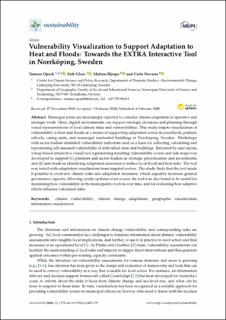| dc.contributor.author | Opach, Tomasz | |
| dc.contributor.author | Glaas, Erik | |
| dc.contributor.author | Hjerpe, Mattias | |
| dc.contributor.author | Navarra, Carlo | |
| dc.date.accessioned | 2021-02-15T08:25:09Z | |
| dc.date.available | 2021-02-15T08:25:09Z | |
| dc.date.created | 2020-02-06T15:54:04Z | |
| dc.date.issued | 2020 | |
| dc.identifier.citation | Sustainability. 2020, 12 (3), . | en_US |
| dc.identifier.issn | 2071-1050 | |
| dc.identifier.uri | https://hdl.handle.net/11250/2727952 | |
| dc.description.abstract | Municipal actors are increasingly expected to consider climate adaptation in operative and strategic work. Here, digital environments can support strategic decisions and planning through visual representations of local climate risks and vulnerabilities. This study targets visualization of vulnerability to heat and floods as a means of supporting adaptation action in preschools, primary schools, caring units, and municipal residential buildings in Norrköping, Sweden. Workshops with sector leaders identified vulnerability indicators used as a basis for collecting, calculating and representing self-assessed vulnerability of individual units and buildings. Informed by user inputs, a map-based interactive visual tool representing resulting vulnerability scores and risk maps was developed to support (1) planners and sector leaders in strategic prioritization and investments, and (2) unit heads in identifying adaptation measures to reduce local flood and heat risks. The tool was tested with adaptation coordinators from targeted sectors. The study finds that the tool made it possible to overview climate risks and adaptation measures, which arguably increases general governance capacity. Allowing yearly updates of set scores, the tool was also found to be useful for monitoring how vulnerability in the municipality evolves over time, and for evaluating how adaptive efforts influence calculated risks. | en_US |
| dc.language.iso | eng | en_US |
| dc.publisher | MDPI | en_US |
| dc.relation.uri | https://www.mdpi.com/2071-1050/12/3/1179/pdf | |
| dc.rights | Navngivelse 4.0 Internasjonal | * |
| dc.rights.uri | http://creativecommons.org/licenses/by/4.0/deed.no | * |
| dc.title | Vulnerability Visualization to Support Adaptation to Heat and Floods: Towards the EXTRA Interactive Tool in Norrköping, Sweden | en_US |
| dc.type | Peer reviewed | en_US |
| dc.type | Journal article | en_US |
| dc.description.version | publishedVersion | en_US |
| dc.subject.nsi | VDP::Romlig, territoriell planlegging: 238 | en_US |
| dc.subject.nsi | VDP::Spatial, territorial planning: 238 | en_US |
| dc.subject.nsi | VDP::Romlig, territoriell planlegging: 238 | en_US |
| dc.subject.nsi | VDP::Spatial, territorial planning: 238 | en_US |
| dc.source.pagenumber | 20 | en_US |
| dc.source.volume | 12 | en_US |
| dc.source.journal | Sustainability | en_US |
| dc.source.issue | 3 | en_US |
| dc.identifier.doi | https://doi.org/10.3390/su12031179 | |
| dc.identifier.cristin | 1791724 | |
| dc.relation.project | Norges forskningsråd: 274192 | en_US |
| dc.relation.project | Vetenskapsrådet: 942–2015‐106 | en_US |
| dc.description.localcode | © 2020 by the authors. Licensee MDPI, Basel, Switzerland. This article is an open access article distributed under the terms and conditions of the Creative Commons Attribution (CC BY) license (http://creativecommons.org/licenses/by/4.0/). | en_US |
| cristin.ispublished | true | |
| cristin.fulltext | original | |
| cristin.qualitycode | 1 | |

